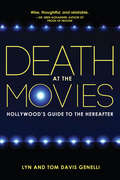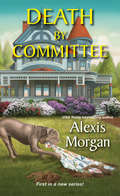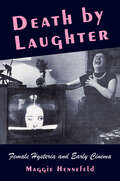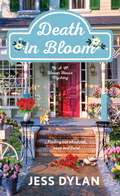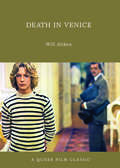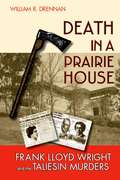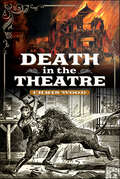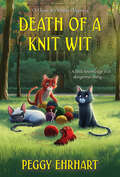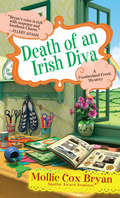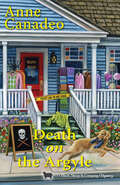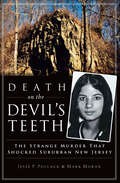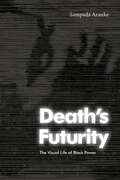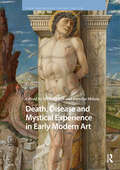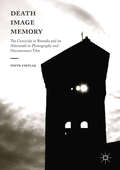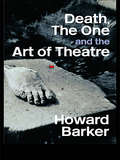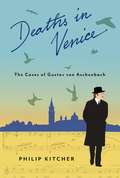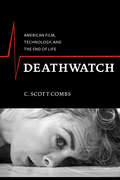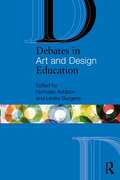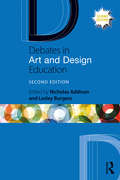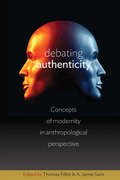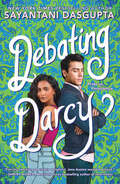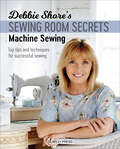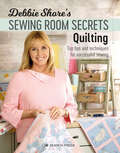- Table View
- List View
Death at the Movies
by Tom And GenelliIt's a Wonderful Life (1946), Resurrection (1980), Poltergeist (1982), Beetlejuice (1988), Ghost (1990), Groundhog Day (1993), The Sixth Sense (1999) - these are only a few of the influential movies in recent decades dealing with the afterlife. But beyond entertainment, do they mean anything? The authors of this wise and well-informed guide believe so. They explore how popular motion pictures, from Outward Bound (1930) to Hereafter, play a perhaps unconscious role in guiding humanity toward its evolutionary comprehension of the meaning and purpose of death. They draw on the Tibetan Book of the Dead, Buddhism, and depth psychology to review some of the most spiritually powerful films ever made. Death is, say the authors, at once the most immediate locked door and the ultimate frontier, a staggering paradox that invites us to search for deeper understanding based upon a level of consciousness beyond thought. After reading this book, you'll never view Casablanca or The Wizard of Oz the same way again.
Death by Committee (An Abby McCree Mystery #1)
by Alexis MorganAn amateur quilter turns amateur sleuth when her late aunt is suspected of murder in this cozy mystery by the USA Today bestselling author. After a rough divorce, Abby McCree only wants to stitch up her life and move on. But other loose ends appear after her elderly Aunt Sybil passes away, leaving Abby to tend to a rundown estate, complete with a slobbery Mastiff and a sexy tenant who growls more than the dog. As Abby learns the local gossip from her aunt&’s tight-knit quilting guild—not to mention the contentious Committee on Senior Affairs—she makes a twisted discovery: Aunt Sybil&’s biggest rival is buried in her backyard! Abby refuses to accept that her beloved aunt had anything to do with the murder. Between her busy social calendar and rediscovering the art of quilting, she tries to clear her aunt&’s name by uncovering the true culprit. As the incriminating clues mount, Abby starts to wonder—can she survive her new responsibilities in Snowberry Creek and still manage to patch together a killer&’s deadly pattern without becoming the next victim?
Death by Laughter: Female Hysteria and Early Cinema (Film and Culture Series)
by Maggie HennefeldCan you really die from laughing too hard? Between 1870 and 1920, hundreds of women suffered such a fate—or so a slew of sensationalist obituaries would have us believe. How could laughter be fatal, and what do these reports of women’s risible deaths tell us about the politics of female joy?Maggie Hennefeld reveals the forgotten histories of “hysterical laughter,” exploring how women’s amusement has been theorized and demonized, suppressed and exploited. In nineteenth-century medicine and culture, hysteria was an ailment that afflicted unruly women on the cusp of emotional or nervous breakdown. Cinema, Hennefeld argues, made it possible for women to laugh outrageously as never before, with irreversible social and political consequences. As female enjoyment became a surefire promise of profitability, alarmist tales of women laughing themselves to death epitomized the tension between subversive pleasure and its violent repression.Hennefeld traces the social politics of women’s laughter from the heyday of nineteenth-century sentimentalism to the collective euphoria of early film spectatorship, traversing contagious dancing outbreaks, hysteria photography, madwomen’s cackling, cinematic close-ups, and screenings of slapstick movies in mental asylums. Placing little-known silent films and an archive of remarkable, often unusual texts in conversation with affect theory, comedy studies, and feminist film theory, this book makes a timely case for the power of hysterical laughter to change the world.
Death in Bloom: A Flower House Mystery (Flower House series #1)
by Jess DylanThe first in a sweet and colorful cozy mystery series from Jess Dylan, Death in Bloom introduces flower shop owner Sierra Ravenswood.At the Flower House, every rose has its thorn . . .Sierra Ravenswood is the new part-time employee of the Flower House, a flower shop in Aerieville, Tennessee. It's true she didn't expect to be back in her hometown at twenty-eight-years-old, but after her dream of making it as a singer in Nashville crashed and burned, she's just grateful to have found a soft place to land.Because, after all, Sierra firmly believes in being optimistic and positive about life, so she's sure she won't have to work at the Flower House forever. But things take a decidedly negative turn when a customer drops dead in the middle of her new bouquet-arranging workshop at the store. When it's discovered he was poisoned by a snack at the event, everyone at the workshop, including Sierra, is on the suspect list. To make matters worse, her boss has gone AWOL and left the store to her for the cost of one dollar, leaving Sierra in charge of both his store and his high-energy Corgi puppy, Gus.The town is on edge, and Sierra knows that murder is something that an upbeat attitude and a bouquet of sweet-smelling roses can't fix. She's determined to figure out whodunit, before anyone else in town meets an untimely reason for needing funeral flowers.
Death in Venice
by Will AitkenA Queer Film Classic on Luchino Visconti's lyrical and controversial 1971 film based on Thomas Mann's novel about a middle-aged man (played by Dirk Bogarde) vacationing in Venice who becomes obsessed with a youth staying at the same hotel as a wave of cholera descends upon the city. The book analyzes its cultural impact and provides a vivid portrait of the director, an ardent Communist and grand provocateur.Will Aitken's novels include Realia and Terre Haute. Arsenal's Queer Film Classics series cover some of the most important and influential films about and by LGBTQ people.
Death in a Prairie House: Frank Lloyd Wright and the Taliesin Murders
by William R. DrennanConstructed in 1911 as a summer home for the architect and his mistress, Frank Lloyd Wright's Taliesin residence stood for only a few years. On an August night in 1914, it became the scene of a brutal mass murder and was almost completely destroyed by fire. In this text, Drennan (English, U. of Wisconsin) traces the events that led up to that night, examines the murderer's motives, and considers the effects of the loss of his home and loved ones on Wright's life and career. Terrace Books is a division of the U. of Wisconsin Press. Annotation ©2007 Book News, Inc., Portland, OR (booknews.com)
Death in the Theatre
by Chris Wood"A richly entertaining account of tragic theatre accidents and murders most foul. If theatre walls could talk, what secrets would they reveal? Chris Wood provides fascinating answers with tales of brawling ushers, murderously jealous husbands, stampeding crowds and infant tragedies. A meticulously researched and vivid collection of lives lost in the palaces of dreams. A must-read for all lovers of the theatre, providing shocks and gasps of horror when real life proves to be more dramatic than any play on stage." - Hugh Bonneville "Immaculately researched and beautifully macabre. This is a real treat for anyone who is either a fan of the theatre or of untimely deaths. I loved it!" - Peter James Britain’s theatrical wonderland has been a cornerstone of culture for centuries, delighting and thrilling audiences with an assemblage of exhilarating spectacles. Beyond the trodden boards, and tucked neatly behind the curtain however, lies a catalogue of real life destruction and grisly murder that our greatest tragedians would surely be proud to have presided over. Tread the bloodied boards of Britain’s theaters and witness the deathly dramas that have played out so dramatically within them. Death in the Theatre collects an astonishing selection of startling tragedies from Britain’s throng of theaters. There is something especially staggering when the player exits life on their adorned stage, and yet, with this by no means an infrequent occurrence, death has made many a fearful cameo appearance – stalking the stalls and grimly reaping the galleries in its macabre and relentless fashion. In 1910 a strange midnight tragedy was enacted in a London theater, where the brutal murder of an elderly stage carpenter prompted huge excitement among the theater-going world and indeed wider public. How did a children’s magic show descend into such unspeakable horror that would leave 183 youngsters dead in a Sunderland theater, their tiny bodies brutally laid out in the dress circle for the bleakest of identity parades? Learn of outrageous tragedy such as the young man mauled to death by a lion in a Gloucester theater, and the unfortunate victim killed in the Dumfries Theatre Royal – quite literally – by the limelight.
Death of a Knit Wit (A Knit & Nibble Mystery #8)
by Peggy EhrhartWhen a professor is poisoned, Pamela Paterson and the members of the Knit and Nibble knitting club must take a crash course in solving his mysterious murder. Pamela has organized a weekend-long knitting bee as part of a conference on fiber arts and crafts at Wendelstaff College. But when pompous Professor Robert Greer-Gordon Critter, the keynote speaker at the conference, crashes the bee, he seems more interested in flirting than knitting. The man&’s reputation as a philanderer supersedes his academic reputation. After coffee and cookies are served, the professor suddenly collapses, seemingly poisoned—but how? Everyone had the coffee and cookies. Joined by her bestie Bettina and the Knit and Nibble ladies, Pamela sorts through everything from red socks to red herrings to unravel the means and motives of a killer dead set on teaching the professor a lesson . . . Praise for Peggy Ehrhart and the Knit & Nibble Mysteries! &“[A] cuisine and character-driven cozy.&”—Kirkus Reviews on Knit of the Living Dead &“With an unlikely heroine and a knack for finding the 'pattern' in the murders, this is a series that will appeal to many cozy fans.&” —The Parkersburg News and Sentinel on Died in the WoolKnitting tips and delicious recipe included!
Death of an Irish Diva (A Cumberland Creek Mystery #3)
by Mollie Cox Bryan"A satisfying and surprising read." —Sheila Connolly, New York Times bestselling author on ScrappedSpring is in the air, but the ladies of the Cumberland Creek Scrapbook Crop hardly have time to stop and smell the roses. Not when famed Irish dancer Emily McGlashen is found murdered in her studio just after the St. Patrick's Day parade--and one of the Crop's own members is the prime suspect. Vera's dance studio may have suffered when Emily waltzed into town, but the croppers know she's not a vengeful murderer. Lucky for her, co-scrapbooker Annie is a freelance reporter eager to vindicate her friend. What she discovers is a puzzling labyrinth of secrets that only add question marks to Emily's murder. Just when it seems they've run out of clues, an antique scrapbook turns up and points the croppers in the right direction--and brings them face to face with a killer more twisted than a Celtic knot. . .Praise for Mollie Cox Bryan"Thought-provoking and well-paced. . . A great story, well told!" —Juliet Blackwell, New York Times bestselling author of the Witchcraft mysteries on Scrapped"Bryan's voice is rich with empathy, suspense, and a healthy dose of Southern charm." —Ellery Adams, New York Times bestselling author of the Charmed Pie Shoppe Mysteries"A font of ingenuity. . .superb entertainment." —Mystery Scene magazine on Scrapbook of SecretsIncludes tips and a glossary of terms for the modern scrapbooker!
Death on the Argyle (A Black Sheep & Co. Mystery #5)
by Anne CanadeoAs one of the Black Sheep Knitters prepares to become a mother, a new member becomes a suspected killer . . . Spring has reached Plum Harbor, Massachusetts, and the weather isn't the only thing that's changing. Eight months pregnant, Lucy prepares to enter an exciting phase in life while weaving together loose threads from her past. It feels like fate when she reconnects with college friend Rebecca Hurley, whose eclectic Happy Hands Café is the perfect locale for Black Sheep gatherings. But just as charming Rebecca joins their closely knit circle, she's suspected of murder. It appears to be an accident when Rebecca&’s writer husband, Colin, is crushed by a fallen bookcase at the café. But his death is quickly determined to be murder. Adding to the horror, police believe Rebecca committed a heinous act of revenge against Colin for planning to end their marriage—a move that would cut off Rebecca&’s contact with the stepdaughter she adores. Despite the incriminating evidence growing faster than her belly, Lucy is convinced that she must prove her old friend's innocence. As her due date approaches and a dangerous mystery unravels, Lucy and the Black Sheep shift from knitting baby booties to chasing down the cunning culprit who&’s always a few steps ahead.
Death on the Devil's Teeth: The Strange Murder That Shocked Suburban New Jersey (True Crime Ser.)
by Mark Moran Jesse P. PollackRumors, witchcraft, and murder in this true crime account of one of New Jersey&’s most notorious cold cases—from two Weird N.J. magazine contributors. As Springfield residents decorated for Halloween in September 1972, the crime rate in the affluent New Jersey township was at its lowest in years. That mood was shattered when the body of sixteen-year-old Jeannette DePalma was discovered in the woods, allegedly surrounded by strange objects. Some feared witchcraft was to blame, while others believed a serial killer was on the loose. Rumors of a police coverup ran rampant, and the case went unsolved—along with the murders of several other young women. Including extensive interviews with DePalma&’s friends and family, new evidence, and theories about who could have committed this horrible crime, Death on the Devil&’s Teeth provides the definitive account of this shocking cold case more that remains a mystery more than four decades later.
Death's Futurity: The Visual Life of Black Power (The Visual Arts of Africa and its Diasporas)
by Sampada ArankeIn Death’s Futurity Sampada Aranke examines the importance of representations of death to Black liberation. Aranke analyzes posters, photographs, journalism, and films that focus on the murders of Black Panther Party members Lil’ Bobby Hutton, Fred Hampton, and George Jackson to construct a visual history of the 1960s and 1970s Black Power era. She shows how Black radicals used these murders to engage in political action that imagined Black futurity from the position of death. Photographs of Hutton that appeared on flyers and posters called attention to the condition of his death while the 1971 documentary The Murder of Fred Hampton enabled the consideration of Hampton’s afterlife through visual meditations on his murder. Printmaking and political posters surrounding Jackson’s murder marked the transition from Black Power to the prison abolition movement in ways that highlighted the relationship between surveillance, policing, incarceration, and anti-Black violence. By foregrounding the photographed, collaged, filmed, and drawn Black body, Aranke demonstrates that corporeality and corpses are crucial to the efforts to shape visions of a Black future free from white supremacy.
Death, Disease and Mystical Experience in Early Modern Art (Visual and Material Culture, 1300-1700)
by Michael Hill Jennifer MilamFear of death and disease preoccupied the European consciousness throughout the early modern era, becoming most acute at times of plague and epidemics. In these times of heightened anxieties, images of saints and protectors served to reassure the faithful of their religious protection against infection. Modes of visual engagement and devotional subject matter were coupled in new ways to reinforce the emotive impact of art works and to reaffirm the perceived reality of the afterlife. In this context, a visual language of mystical devotion, which overcame the limits of the body and even eroticised its suffering, could serve the needs of the desolate and the pained. In this series of essays focused on spiritual sensibilities in Renaissance art and its legacies, authors present original ideas about the themes of death, disease, and mystical experience, based primarily on the study of objects and their documented historical contexts. Methodologically wide-ranging in approach, the resulting volume provides novel insights into the interplay between suffering and art making in the Western world.
Death, Image, Memory
by Piotr CieplakThis book explores how photography and documentary film have participated in the representation of the 1994 genocide in Rwanda and its aftermath. This in-depth analysis of professional and amateur photography and the work of Rwandan and international filmmakers offers an insight into not only the unique ability of images to engage with death, memory and the need for evidence, but also their helplessness and inadequacy when confronted with the enormity of the event. Focusing on a range of films and photographs, the book tests notions of truth, evidence, record and witnessing - so often associated with documentary practice - in the specific context of Rwanda and the wider representational framework of African conflict and suffering. Death, Image, Memory is an inquiry into the multiple memorial and evidentiary functions of images that transcends the usual investigations into whether photography and documentary film can reliably attest to the occurrence and truth of an event.
Death, The One and the Art of Theatre
by Howard BarkerDeath, The One and the Art of Theatre is the latest collection of Barkers distinctive and revelatory philosophical musings on theatre. It is a stunning array of speculations, deductions, prose poems and poetic aperçus that casts a unique and unflinching light on the nature of tragedy, eroticism, love and theatre. Exploring the juncture between aesthetics and metaphysics, the book looks at the human experience of love and death as life at its most intrinsically theatrical. Howard Barker is an internationally renowned playwright whose works are regularly produced throughout Europe and the US. He is widely known for his controversial explorations into contemporary tragedy and his anti-Brechtian focus on the irrational and the catastrophic. He is often credited as a major influence on the generation of playwrights that includes Sarah Kane. Death, The One and the Art of the Theatre is a profoundly unsettling and inspiring piece of writing and extends the challenge to orthodox morality that Barker first presented in Arguments for a Theatre, a challenge he describes as men and womens secret longing for the incomprehensible nature of pain.
Deaths in Venice: The Cases of Gustav von Aschenbach (Leonard Hastings Schoff Lectures)
by Philip KitcherPublished in 1913, Thomas Mann's Death in Venice is one of the most widely read novellas in any language. In the 1970s, Benjamin Britten adapted it into an opera, and Luchino Visconti turned it into a successful film. Reading these works from a philosophical perspective, Philip Kitcher connects the predicament of the novella's central character to Western thought's most compelling questions. In Mann's story, the author Gustav von Aschenbach becomes captivated by an adolescent boy, first seen on the lido in Venice, the eventual site of Aschenbach's own death. Mann works through central concerns about how to live, explored with equal intensity by his German predecessors, Schopenhauer and Nietzsche. Kitcher considers how Mann's, Britten's, and Visconti's treatments illuminate the tension between social and ethical values and an artist's sensitivity to beauty. Each work asks whether a life devoted to self-sacrifice in the pursuit of lasting achievements can be sustained and whether the breakdown of discipline undercuts its worth. Haunted by the prospect of his death, Aschenbach also helps us reflect on whether it is possible to achieve anything in full awareness of our finitude and in knowing our successes are always incomplete.
Deathwatch
by C. Scott CombsThe first study to unpack American cinema's long history of representing death
Deathwatch: American Film, Technology, and the End of Life
by Combs C. ScottThe first study to unpack American cinema's long history of representing death
Deathwatch: American Film, Technology, and the End of Life (Film and Culture Series)
by C. Scott CombsThe first book to unpack American cinema's long history of representing death, this work considers movie sequences in which the process of dying becomes an exercise in legibility and exploration for the camera. Reading attractions-based cinema, narrative films, early sound cinema, and films using voiceover or images of medical technology, C. Scott Combs connects the slow or static process of dying to formal film innovation throughout the twentieth century. He looks at Thomas Edison's Electrocuting an Elephant (1903), D. W. Griffith's The Country Doctor (1909), John Ford's How Green Was My Valley (1941), Billy Wilder's Sunset Boulevard (1950), Stanley Kubrick's 2001: A Space Odyssey (1968), and Clint Eastwood's Million Dollar Baby (2004), among other films, to argue against the notion that film cannot capture the end of life because it cannot stop moving forward. Instead, he shows how the end of dying occurs more than once and in more than one place, understanding death in cinema as constantly in flux, wedged between technological precision and embodied perception.
Debates in Art and Design Education (Debates in Subject Teaching)
by Nicholas Addison Lesley BurgessDebates in Art and Design Education encourages student and practising teachers to engage with contemporary issues and developments in learning and teaching. It introduces key issues, concepts and tensions in order to help art educators develop a critical approach to their practice in response to the changing fields of education and visual culture. Accessible, comprehensive chapters are designed to stimulate thinking and understanding in relation to theory and practice, and help art educators to make informed judgements by arguing from a position based on theoretical knowledge and understanding. Contributing artists, lecturers and teachers debate a wide range of issues including: the latest policy and initiatives in secondary art education the concepts, skills and dispositions that can be developed through art education tensions inherent in developing the inclusive Art and Design classroom partnerships across the visual arts sector creativity in the Art and Design curriculum visual art and globalisation establishing the significance of ‘Design’ art practice as educational research. Debates in Art and Design Education is for all student and practising teachers interested in furthering their understanding of an exciting, ever-changing field, and supports art educators in articulating how the subject is a vital, engaging and necessary part of the twenty-first century curriculum. Each chapter points to further reading and each section suggests reflective questions to help shape art educators’ teaching. In particular, Debates in Art and Design Education encourages art educators to engage in research by providing an essential introduction to critical thinking around contemporary debates.
Debates in Art and Design Education (Debates in Subject Teaching)
by Nicholas Addison and Lesley BurgessDebates in Art and Design Education encourages student and practising teachers to engage with contemporary issues and developments in learning and teaching. This fully updated second edition introduces key issues, concepts and tensions in order to help art educators develop a critical approach to their practice in response to the changing fields of education and visual culture. Accessible, comprehensive chapters are designed to stimulate thinking and understanding in relation to theory and practice, and help art educators to make informed judgements by arguing from a position based on theoretical knowledge and understanding. Contributing artists, lecturers and teachers debate a wide range of issues including: the latest policy and initiatives in secondary art education the concepts, skills and dispositions that can be developed through art education tensions inherent in developing the inclusive Art and Design classroom citizenship education within Art and Design teaching new practices in community arts education examining ‘whiteness’ in the sector Debates in Art and Design Education is for all student and practising teachers interested in furthering their understanding of an exciting, ever-changing field, and supports art educators in articulating how the subject is a vital, engaging and necessary part of the twenty-first century curriculum.
Debating Authenticity
by Thomas Fillitz A. Jamie SarisThe longing for authenticity, on an individual or collective level, connects the search for external expressions to internal orientations. What is largely referred to as production of authenticity is a reformulation of cultural values and norms within the ongoing process of modernity, impacted by globalization and contemporary transnational cultural flows. This collection interrogates the notion of authenticity from an anthropological point of view and considers authenticity in terms of how meaning is produced in and through discourses about authenticity. Incorporating case studies from four continents, the topics reach from art and colonialism to exoticism-primitivism, film, ritual and wilderness. Some contributors emphasise the dichotomy between the academic use of the term and the one deployed in public spaces and political projects. All, however, consider authenticity as something that can only be understood ethnographically, and not as a simple characteristic or category used to distinguish some behaviors, experiences or material things from other less authentic versions.
Debating Darcy
by Sayantani DasGuptaThis Pride & Prejudice retelling brings New York Times bestselling Sayantani DasGupta’s trademark wit and insight to her bright and funny YA debut!It is a truth universally acknowledged that Leela Bose plays to win.A life-long speech competitor, Leela loves nothing more than crushing the competition, all while wearing a smile. But when she meets the incorrigible Firoze Darcy, a debater from an elitist private school, Leela can’t stand him. Unfortunately, he’ll be competing in the state league, so their paths are set to collide. But why attempt to tolerate Firoze when Leela can one-up him? The situation is more complicated than Leela anticipated, though, and her participation in the tournament reveals that she might have tragically misjudged the debaters -- including Firoze Darcy -- and more than just her own winning streak is at stake…her heart is, too. Debating Darcy is bestselling author Sayantani DasGupta’s reinterpretation of beloved classic Pride and Prejudice -- imaginative, hilarious, thought-provoking, and truly reflective of the complex, diverse world of American high school culture.
Debbie Shore's Sewing Room Secrets—Machine Sewing
by Debbie ShoreIn this first book in her new Sewing Room Secrets series, Debbie Shore walks you through every aspect of machine sewing, revealing her top tips and providing in-depth and helpful guidance every step of the way. Starting by looking at sewing room essentials, Debbie then guides you around your sewing machine and explains all the tools and materials you might need, including wadding/batting, interfacing, fabrics and threads. There’s a handy troubleshooting section to reassure and guide you when you encounter problems. Debbie covers the key techniques you need to know, including inserting zips and piping, using shirring elastic, free-motion embroidery and appliqué. Debbie’s focus is on craft and home items, but she also includes some dressmaking and quilting tips for those looking to explore other areas. The ten beautiful projects help you learn the techniques as you progress through the book, beginning with a simple pincushion before moving on to a pillow cover, a tablet case, a drawstring bag, a sewing machine mat and more.
Debbie Shore's Sewing Room Secrets—Quilting: Top Tips and Techniques for Successful Sewing (Debbie Shore's Sewing Room Secrets Ser.)
by Debbie ShoreEssential tips and ten quilting projects to build your skills and confidence—from the beloved sewing teacher and British television personality.This book is packed with hints and tips for successful quilting and will walk you through every aspect of your sewing journey. It begins with a section on Sewing Room Essentials: a peek in Debbie’s sewing room, a guide to all the tools and materials you might need, a labelled diagram of a sewing machine, and in-depth sections covering various types of wadding/batting and interfacing, fabrics, and threads. The book contains a comprehensive trouble-shooting section to reassure and guide beginner sewists when they encounter problems, along with a glossary to demystify any unfamiliar terms.The second section, Sewing Room Techniques, covers all the skills you need to know, such as pressing, chain piecing, English paper piecing, different quilting styles, and binding, and explains them step by step. The book features ten projects that build up in difficulty, incorporating the techniques you learn as you go. Start simple with a place mat and then build up your skills as you create an English paper-pieced tote, a baby quilt, and a clutch bag.This is the ideal book for the beginner sewist looking for in-depth and helpful guidance, or for the more experienced sewist looking to brush up on their skills—from the woman named “Sewing Designer of the Year” in the Immediate Media British Craft Awards.
